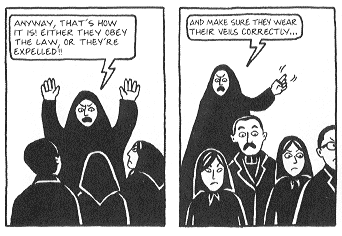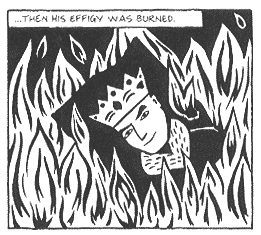 By Marjane Satrapi
By Marjane Satrapi
160 pages, black and white
Published by Pantheon Books
It’s hard to be compared to a legend. Advance word on the translation of Marjane Satrapi’s Persepolis: The Story of a Childhood, the story of her childhood growing up in Iran, was pretty positive. So positive, in fact, that the comparison of Persepolis to the Pulitzer Prize-winning Maus was one I kept hearing get thrown around. The problem with being compared to something that powerful is that if the comparison isn’t completely accurate, it’s going to make the new work look poor in comparison. Now, I don’t know if this is the new Maus… but this sure is an awfully powerful book in its own right.
Marjane Satrapi is very much her mother’s daughter; she’s headstrong, outspoken, and is going to do whatever she wants to. Unfortunately, when you’re growing up in 1980s Iran, this can be extremely dangerous. As Marji’s country is shaken by political and religious turmoil, Marji struggles to go about her normal life despite the continual changes in her life. What Marji will soon realize, though, is that there’s no way she’ll ever have a “normal life” again.
 In her introduction, Satrapi states, “I believe that an entire nation should not be judged by the wrongdoings of a few extremists. I also don’t want those Iranians who lost their lives in prisons defending freedom, who died in the war against Iraq, who suffered under various repressive regimes, or who were forced to leave their families and flee their homeland to be forgotten.” Reading Persepolis, I think she’s doing a good job of both representing the nation of Iran, and making sure that those she mentioned are not forgotten. I suspect I would have been interested in Persepolis simply because of the subject material, but it’s much more than that thanks to Satrapi’s writing style. She’s able to pull the reader into her story in her easy, conversational style of storytelling. Separated out into a series of smaller vignettes, Satrapi is able to start her story in a relatively innocent time, slowly expanding Marji’s worldview as things begin to collapse, going from bad to worse in the blink of an eye. Perhaps most importantly, Satrapi is able to bring across her childhood perspective. It would be very easy to bring an adult’s cynicism to these events, but there’s still an innocence and surprise about Satrapi’s memories… and an eventual shattering of that innocence in an heartbreaking sequence that would haunt almost anyone in that situation.
In her introduction, Satrapi states, “I believe that an entire nation should not be judged by the wrongdoings of a few extremists. I also don’t want those Iranians who lost their lives in prisons defending freedom, who died in the war against Iraq, who suffered under various repressive regimes, or who were forced to leave their families and flee their homeland to be forgotten.” Reading Persepolis, I think she’s doing a good job of both representing the nation of Iran, and making sure that those she mentioned are not forgotten. I suspect I would have been interested in Persepolis simply because of the subject material, but it’s much more than that thanks to Satrapi’s writing style. She’s able to pull the reader into her story in her easy, conversational style of storytelling. Separated out into a series of smaller vignettes, Satrapi is able to start her story in a relatively innocent time, slowly expanding Marji’s worldview as things begin to collapse, going from bad to worse in the blink of an eye. Perhaps most importantly, Satrapi is able to bring across her childhood perspective. It would be very easy to bring an adult’s cynicism to these events, but there’s still an innocence and surprise about Satrapi’s memories… and an eventual shattering of that innocence in an heartbreaking sequence that would haunt almost anyone in that situation.
 In the acknowledgements for Persepolis, Satrapi thanks French artist David B. That couldn’t help but bring a smile to my face, since I’d kept thinking how much Satrapi’s art reminded me of his work. It’s got a wonderfully stripped down look, but don’t take that for a lack of expression. It’s amazing how easily Satrapi is able to bring emotion to her family and friend’s faces as things go from bad to worse. More importantly, Satrapi’s able to bring real terror into her art. Images like the Shah’s picture burning in flames, or armies going after their own countrymen are surprisingly grim, and really help bring home the events of her story.
In the acknowledgements for Persepolis, Satrapi thanks French artist David B. That couldn’t help but bring a smile to my face, since I’d kept thinking how much Satrapi’s art reminded me of his work. It’s got a wonderfully stripped down look, but don’t take that for a lack of expression. It’s amazing how easily Satrapi is able to bring emotion to her family and friend’s faces as things go from bad to worse. More importantly, Satrapi’s able to bring real terror into her art. Images like the Shah’s picture burning in flames, or armies going after their own countrymen are surprisingly grim, and really help bring home the events of her story.
Satrapi’s story is something that’s going to appeal to a very wide audience, it’s told in a style that can be appreciated by just about anyone. With Pantheon Books behind Persepolis: The Story of a Childhood, this might just get into the hands of a much wider audience. The more I look at the book, the more I’m convinced that it’s something that should. Satrapi’s biography mentions that she’s hard at work on the next installment of Persepolis; me, I can’t wait.
